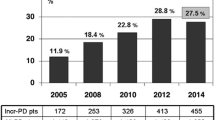Abstract
Automated peritoneal dialysis (APD) has been considered as the ideal dialysis modality for pediatric patients. This study reports the 3-year APD experience with 458 end-stage renal disease (ESRD) children who started APD in a single pediatric center in Mexico City between June 2003 and June 2006. By June 2003, there were 310 patients being treated with continuous ambulatory peritoneal dialysis (CAPD). At that time, these patients were gradually switched to APD, with priority being given to those prescribed more than four exchanges per day, younger than 6 years of age, or presenting complications [hernias or decreased ultrafiltration (UF)]. An improvement of daily UF was observed when the patients were switched from CAPD (590 ± 340 ml/day) to APD (846 ± 335 ml/day). The presence of edema decreased (from 67% to 8%) as well as the percentage of patients requiring antihypertensive drugs (from 83% to 38%), the peritonitis rate improved from one episode every 35 patient/month to one episode every 47 patient/month, the total number of hospitalizations decreased (from 384 to 51), and 85% of children attended school. While waiting for renal transplant, APD is the dialysis modality of choice for ESRD children at the La Raza Medical Center in Mexico City.






Similar content being viewed by others
References
Ardissino G, Dacco V, Testa S, Bonaudo R, Claris-Appiani A, Taioli E, Marra G, Edefonti A, Sereni F (2003) Epidemiology of chronic renal failure in children: data from the ItalKid project. Pediatrics 111:e382–e387
Harmon WE (1995) Treatment of children with chronic renal failure. Kidney Int 47:951–961
United States Renal Data System (1999) Annual Data Report. VIII. Pediatric end-stage renal disease. Am J Kidney Dis 34:S102–S113
Fine RN, Ho M (2002) The role of APD in the management of pediatric patients: a report of the North American Pediatric Renal Transplant Cooperative Study. Semin Dial 15:427–429
Verrina E, Zacchello G, Edefonti A, Sorino P, Rinaldi S, Gianoglio B, Lavoratti G, Maringhini S, Perfumo F (2001) A multicenter survey on automated peritoneal dialysis prescription in children. Adv Perit Dial 17:264–268
Warady BA, Sullivan EK, Alexander SR (1996) Lessons from the peritoneal dialysis patient database: a report of the North American Pediatric Renal Transplant Cooperative Study. Kidney Int Suppl 53:S68–S71
Blake PG (1999) Advantages and disadvantages of automated peritoneal dialysis compared to continuous ambulatory peritoneal dialysis. Perit Dial Int 19(Suppl 2):S121–S124
Tzamaloukas AH, Saddler MC, Murata GH, Malhotra D, Sena P, Simon D, Hawkins KL, Morgan K, Nevarez M, Wood B, Elledge L, Gibel LJ (1995) Symptomatic fluid retention in patients on continuous peritoneal dialysis. J Am Soc Nephrol 6:198–206
Aranda RA, Romao Junior JE, Kakehashi E, Domingos W, Sabbaga E, Marcondes M, Abensur H (2000) Intraperitoneal pressure and hernias in children on peritoneal dialysis. Pediatr Nephrol 14:22–24
Fischbach M, Terzic J, Bergere V, Gaugler C, Provot E (1999) The optimal approach to peritoneal dialysis prescription in children. Perit Dial Int 19(Suppl 2):462–466
Becker N, Brandt JR, Sutherland TA, Avner ED, Watkins SL (1997) Improved outcome of young children on nightly automated peritoneal dialysis. Pediatr Nephrol 11:676–679
Verrina E, Edefonti A, Gianoglio B, Rinaldi S, Sorino P, Zacchello G, Lavoratti G, Maringhini S, Pecoraro C, Calevo MG, Turrini Dertenois L, Perfumo F (2004) A multicenter experience on patient and technique survival in children on chronic dialysis. Pediatr Nephrol 19:82–90
Garcia-Garcia G, Monteon-Ramos JF, Garcia-Bejarano H, Gomez-Navarro B, Reyes IH, Lomeli AM, Palomeque M, Cortes-Sanabria L, Breien-Alcaraz H, Ruiz-Morales NM (2005) Renal replacement therapy among disadvantaged populations in Mexico: a report from the Jalisco Dialysis and Transplant Registry (REDTJAL). Kidney Int Suppl: S58–S61
Schwartz GJ, Haycock GB, Edelmann CM Jr, Spitzer A (1976) A simple estimate of glomerular filtration rate in children derived from body length and plasma creatinine. Pediatrics 58:259–263
Lerner GR, Warady BA, Sullivan EK, Alexander SR (1999) Chronic dialysis in children and adolescents. The 1996 annual report of the North American Pediatric Renal Transplant Cooperative Study. Pediatr Nephrol 13:404–417
Schaefer F, Langenbeck D, Heckert KH, Scharer K, Mehls O (1992) Evaluation of peritoneal solute transfer by the peritoneal equilibration test in children. Adv Perit Dial 8:410–415
Warady BA, Alexander SR, Hossli S, Vonesh E, Geary D, Watkins S, Salusky IB, Kohaut EC (1996) Peritoneal membrane transport function in children receiving long-term dialysis. J Am Soc Nephrol 7:2385–2391
Verrina E, Perfumo F, Gusmano R (1999) Automated peritoneal dialysis prescription and results in children. Contrib Nephrol 129:123–133
Schurman SJ, Shoemaker LR, Warady BA (2000) Urea kinetic analysis of automated peritoneal dialysis allows calculation of a CAPD-equivalent Kt/V(urea). Kidney Int 58:1318–1324
Schaefer F, Klaus G, Muller-Wiefel DE, Mehls O (1999) Current practice of peritoneal dialysis in children: results of a longitudinal survey. Mid European Pediatric Peritoneal Dialysis Study Group (MEPPS). Perit Dial Int 19(Suppl 2):S445–S449
Acknowledgements
We express our gratitude to renal nurses Elia González Ramos, Maria Elena Escudero Arriaga, Maria Concepción García Silva, Maritza Olivia Benítez Cervantes and social worker Margarita Peña Guerrero and assistant Martha González Aguilar for their technical support, and to Dr. Jaime Antonio Zaldivar Cervera, General Director of the General Hospital, National Medical Center “La Raza”.
Author information
Authors and Affiliations
Corresponding author
Additional information
Dr. Divino Filho is an employee of Baxter Health Care and holds stock in the company.
Rights and permissions
About this article
Cite this article
Fabian Velasco, R., Lagunas Muñoz, J., Sanchez Saavedra, V. et al. Automated peritoneal dialysis as the modality of choice: a single-center, 3-year experience with 458 children in Mexico. Pediatr Nephrol 23, 465–471 (2008). https://doi.org/10.1007/s00467-007-0638-4
Received:
Revised:
Accepted:
Published:
Issue Date:
DOI: https://doi.org/10.1007/s00467-007-0638-4




